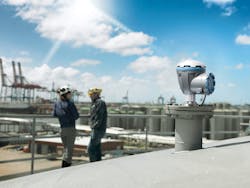Emerson Process Management’s Smart Wireless networks, which are based on WirelessHART technology, have now achieved 1 billion hours of operating experience across more than 10,000 wireless networks. This was some of the biggest news to come out of the Emerson User Exchange event, held in Anaheim, Calif. in October, and it represents a coming out party of sorts for industrial wireless technology.
“This is a milestone event revealing how engineers now consider this a proven technology,” said Bob Karschnia, vice president of the Wireless business unit for Emerson Process Management. “Some customers have even written practices where they look at wireless solutions before wired ones when evaluating new projects.” Before end of the calendar year, Emerson expects to have exceeded 100,000 wireless devices installed,” he added.
Karschnia said Emerson customers have been adopting the technology at such a rapid rate that installations are now measured by the number of gateways installed and the number of operating hours. The total number of hours was calculated conservatively, he said, allowing for customer installation time before operation commenced.
“You don’t get to 2 billion hours without going after broader set of applications,” Karschnia said, “and we have. Many of customers have challenges that are odds compared to the general IT industry,” but wireless communication is proving effective. Among the industries benefiting the most from wireless technology are upstream oil & gas producers, refineries, and chemical facilities.
In addition to multiple refinery/wellhead/pipeline applications, Emerson lists dozens of others on its PlantWeb/Smart Wireless application site. These include sugar bin motor monitoring, boiler and heater gas flow, steam flow accounting, blast furnace health, and control network bridging, to name just a few.
“We knew wireless technology offered substantial savings and it is gratifying to see its rapid and widespread adoption,” Karschnia added. “Many companies started out with small installations to prove the concept in their operating facilities. Today, those starter systems are rapidly expanding to site-wide facilities.” He cited projects in their early stages in which they’re installing 4, 000 wireless nodes. Another with 6,000 nodes, “and one 15, 000 nodes planned,” he said. “Not just the number but the scope [of wireless sensor project] is growing pretty dramatically.”
So how long before Emerson hits 2 billion operating hours for wireless? “By the time we’re here next year, we’ll have exceeded 2 billion hours,” Karschnia predicted.
Products and applications
At the Exchange, Emerson was showcasing new wireless communications products and services, including an IEC62591-compliant WirelessHART Interface for use with Emerson Remote terminal units (RTUs), a Smart Wireless Gateway with native Ethernet/IP output, and a free online tool to help with WirelessHART network planning, which offers an easy, low risk way to see how to use wireless technology.
“Our gateways are the center of our wireless network,” said Karschnia, “and Ethernet/IP enables native communications with PLCs. Power over Ethernet is coming, and it will be an easier way to bring power to the device.”
Another product on display was the Fisher 4320 Wireless Position Monitor with On/Off Control Output Option, reportedly the first and only WirelessHART valve automation solution that includes linkage-less position feedback and discrete valve control. “Our customer have used our [wireless] devices for the front end element, then passed [control signals] over a wired network to a valve. This is the first battery operated valve,” he explained.
In the Technology Exhibits area, where more than 50 Alliance Partners showed their wares, Perpetuum Ltd. announced availability of a vibration-energy-harvesting power module option for Emerson’s Rosemount 3051S Smart Wireless transmitters.
Karschnia said the drivers of wireless projects include much lower cost for wiring and the infrastructure associated with wiring. Also, “the biggest risk on projects is time, so it comes down to how adaptable you are to inevitable changes. Wireless reduces the risk because you are reducing the time needed,” he said.
Since its release five years ago, Emerson estimates that the total installed savings resulting from Smart Wireless field devices is more than $350 million, and reductions in commissioning and installation time total 16 man-years. The adoption of this technology has now spread to more than 120 countries and more than 10,000 separate wireless systems, Karschnia said.

